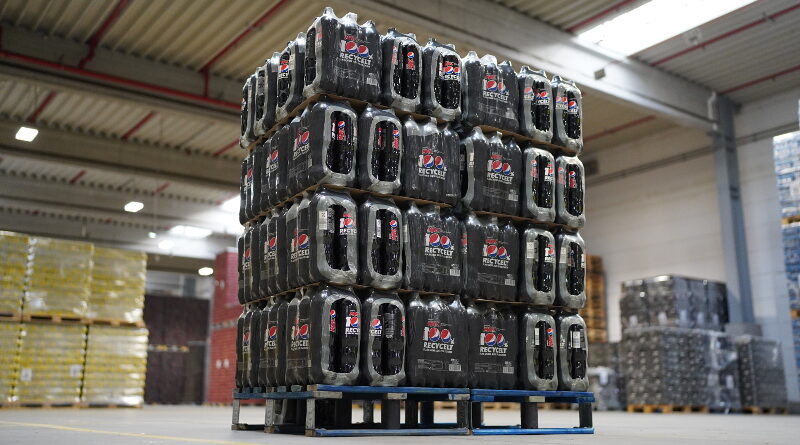Shrink film pilot project
The PepsiCo company has implemented a test project with the German dual system “Grüner Punkt” (“Green Dot”) in which the container film for Pepsi bottles and cans is made from 10% recycled plastic from the yellow bag, 40% recycled plastic from other sources and only half from new plastic. If further quality tests are successful, the next goal is to switch regular production – to film from film.
In October 2021, PepsiCo switched to 100% rPET for all carbonated beverage bottles and the Lipton Icetea range. Bottles and beverage cans, however, are mostly sold in shrink film as six-packs, which in turn are sold on pallets. For safe transport, the six-packs are wrapped with metre-long pallet film sheets. Everything is made of new plastic. The industry-standard high quality of the pack film results from the obligation for stability and the desire to print on it. “This is a charming way to attract the attention of consumers and to distinguish ourselves, as well as an expression of our quality standards in design and thus an important marketing tool,” says Kai Klicker-Brunner, Head of Corporate Affairs and part of the management of PepsiCo Germany. “But they end up in the rubbish very quickly. That’s why we asked our foil suppliers to come up with a recycled version for us.”
The pilot test at the beginning of December 2021 at the Pepsi plant in Niederroden on the packaging lines for 0.33-litre cans and 1.5-litre PET bottles was a pioneering success, states Pepsi: 50% of the container films in the test run were made of recycled material. One fifth of the recycled LDPE (low-density polyethylene, soft polyethylene) in the shrink film was replaced by recyclate from the yellow bag.
To understand the significance of this pilot project, it is important to know that up to a quarter of the packaging waste in the yellow bag or yellow bin throughout Europe consists of film. Systec Plastics Eisfeld has been recycling this for a long time. But this is a huge effort for the Green Dot subsidiary. “Film has a very large surface area and therefore absorbs dirt like a sponge, always remains grey, still smells strong even after cleaning and is not as dense as, for example, the hard plastic of a yoghurt pot,” explains Der Grüne Punkt Press Officer Norbert Völl. While more than half of the plastic waste in the Yellow Bag is turned into high-quality new recycling products, including packaging for detergents, cleaning agents and cleaning products, for example, the films are only turned into simple products such as construction buckets or lawn grids. “That was too limited for us, so we developed a new process.”
The sorted-out films are cleaned and shredded after quality control. These plastic shreds go into an extruder, are melted and out comes a granulate. “This new recyclate, which we call Systalen, can be used to make much higher quality products, including flexible packaging,” says Norbert Völl. This development is only at the beginning. The initial total of 10 % added to the film is to grow successively. The goal is clean material for new, stable films.
In the future, the packaging film will no longer look as clear and bright as it has in the past. “But if people know and understand why the packaging looks different, they will certainly be happy to put up with it,” Kai Klicker-Brunner from PepsiCo is certain.

